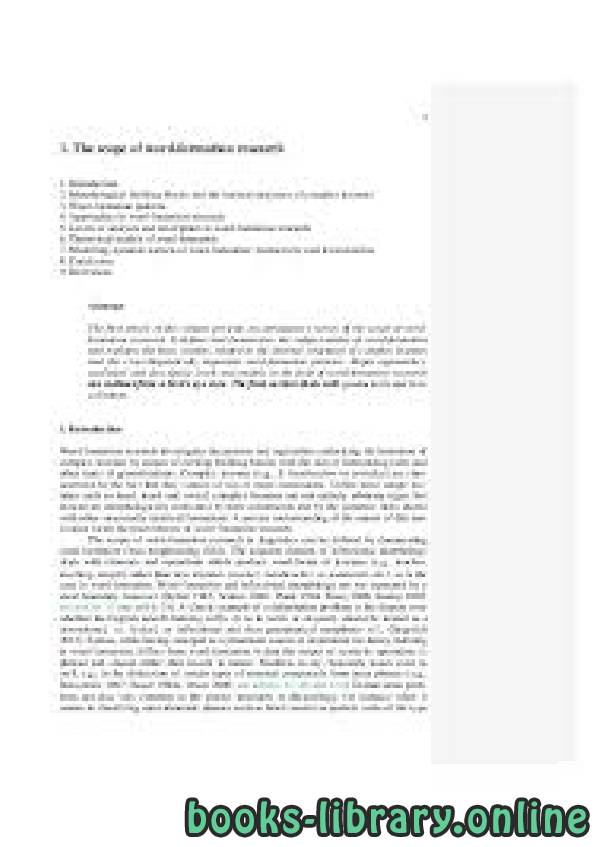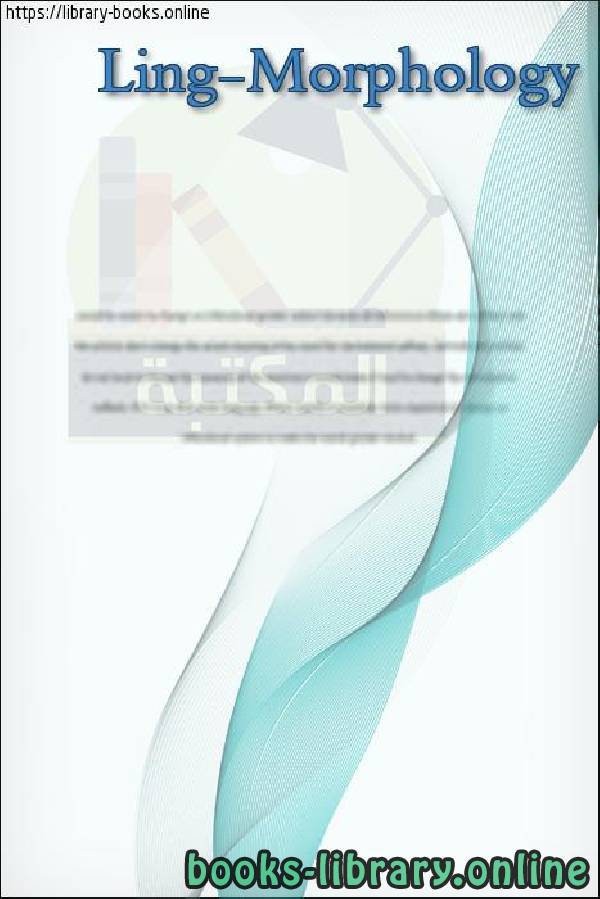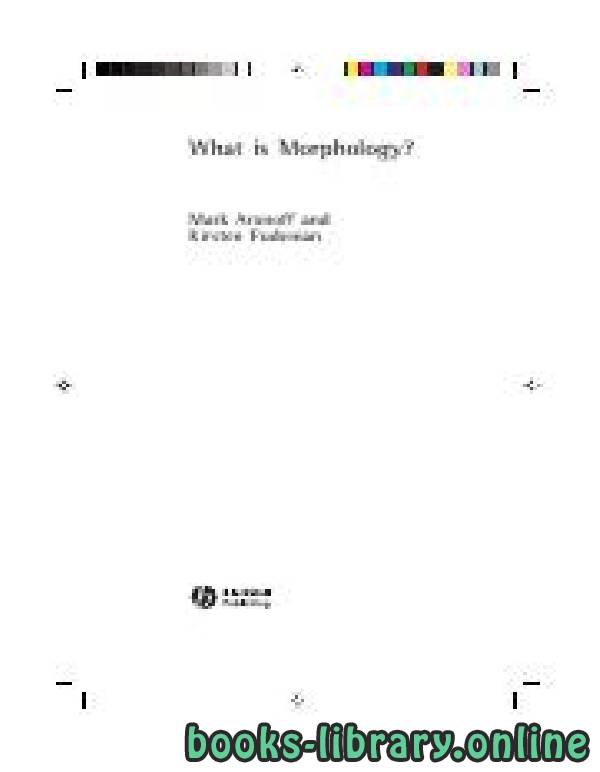كتاب Chapter 4: Morphology Hans-Jörg Schmid
DRAFT VERSION! Quote the published version which includes extra material: Schmid, Hans-Jörg (2015), "Morphology". In: Natalie Braber, Louise Cummings and Liz Morrish, eds., Exploring Language and Linguistics, Cambridge: Cambridge University Press, 77-110. Chapter 4: Morphology Hans-Jörg Schmid Abstract Preview: In this chapter you will first learn to segment words into their smallest meaningful parts, their morphemes. Different types of morphemes will then be distinguished on a number of dimensions. The classes arising from such distinctions are useful because they allow us to formulate generalizations about the properties shared by the members of these classes and the restrictions they are subject to. A second type of generalization covered in this chapter concerns the patterns and rules which underlie the formation of complex lexemes, i.e. words that are made up of more than two lexical morphemes. This is the realm of word-formation. You will be introduced to the range of word-formation patterns that can be used to form new words with the help of existing words and morphemes, including compounding, i.e. the joining of two or more words to form a new complex lexeme (e.g. interest rate, washing-machine or watertight), prefixation, yielding words such as disagree, unjust or ex-minister, and suffixation (e.g. agreement, justify, ministerial). Further word-formation patterns, which are less regular and transparent, include conversion (hammer N to hammer V or empty Adj to empty V), back-formation (e.g. to sightsee sightseeing; to burgle burglar), blending (e.g. infotainment information + entertainment), clipping (e.g. ad advertisement, phone telephone), and the formation of acronyms or initialisms from fixed sequences of words (URL unique resource locator; NATO North Atlantic Treaty Organization). 4.1 Introduction Generally speaking, the linguistic discipline of morphology – the term is derived from the Greek word morphos meaning " form " – examines the internal makeup and structure of words as well as the patterns and principles underlying their composition. In doing so, morphology straddles the traditional boundary between grammar (i.e. the rule-based, productive component of a language) and the lexicon (i.e. the idiosyncratic, rote-learned component). Morphology looks at both sides of linguistic signs, i.e. at the form and the meaning, combining the two perspectives in order to analyse and describe both the component parts of words and the principles underlying the composition of words.Hans-Jörg Schmid - ❰ له مجموعة من الإنجازات والمؤلفات أبرزها ❞ Linguistic Theories, Approaches, and Methods ❝ ❞ Chapter 4: Morphology Hans-Jörg Schmid ❝ ❱
من الصرف Morphology كتب تعلم اللغة الإنجليزية - مكتبة كتب تعلم اللغات.

قراءة كتاب Chapter 4: Morphology Hans-Jörg Schmid أونلاين
معلومات عن كتاب Chapter 4: Morphology Hans-Jörg Schmid:
DRAFT VERSION! Quote the published version which includes extra material: Schmid, Hans-Jörg (2015), "Morphology". In: Natalie Braber, Louise Cummings and Liz Morrish, eds., Exploring Language and Linguistics, Cambridge: Cambridge University Press, 77-110.
Chapter 4: Morphology Hans-Jörg Schmid
Abstract
Preview: In this chapter you will first learn to segment words into their smallest meaningful parts, their morphemes. Different types of morphemes will then be distinguished on a number of dimensions. The classes arising from such distinctions are useful because they allow us to formulate generalizations about the properties shared by the members of these classes and the restrictions they are subject to. A second type of generalization covered in this chapter concerns the patterns and rules which underlie the formation of complex lexemes, i.e. words that are made up of more than two lexical morphemes. This is the realm of word-formation. You will be introduced to the range of word-formation patterns that can be used to form new words with the help of existing words and morphemes, including compounding, i.e. the joining of two or more words to form a new complex lexeme (e.g. interest rate, washing-machine or watertight), prefixation, yielding words such as disagree, unjust or ex-minister, and suffixation (e.g. agreement, justify, ministerial). Further word-formation patterns, which are less regular and transparent, include conversion (hammer N to hammer V or empty Adj to empty V), back-formation (e.g. to sightsee sightseeing; to burgle burglar), blending (e.g. infotainment information + entertainment), clipping (e.g. ad advertisement, phone telephone), and the formation of acronyms or initialisms from fixed sequences of words (URL unique resource locator; NATO North Atlantic Treaty Organization). 4.1 Introduction Generally speaking, the linguistic discipline of morphology – the term is derived from the Greek word morphos meaning " form " – examines the internal makeup and structure of words as well as the patterns and principles underlying their composition. In doing so, morphology straddles the traditional boundary between grammar (i.e. the rule-based, productive component of a language) and the lexicon (i.e. the idiosyncratic, rote-learned component). Morphology looks at both sides of linguistic signs, i.e. at the form and the meaning, combining the two perspectives in order to analyse and describe both the component parts of words and the principles underlying the composition of words.
سنة النشر : 2015م / 1436هـ .
عدد مرات التحميل : 5362 مرّة / مرات.
تم اضافته في : الأربعاء , 18 ديسمبر 2019م.
حجم الكتاب عند التحميل : 0.3MB .
تعليقات ومناقشات حول الكتاب:
هذا القسم يحتوي علي كل ما يخص بعلم الصرف
يتوفر علم الصرف على تبيان تأليف الكلمة المفردة بتبيان وزنها وعدد حروفها و حركاتها و ترتيبها، و ما يعرض لذلك من تغيير وحذف، وما في حروفها و حركاتها و ترتيبهما، وما في حروف الكلمة من اصالة و زيادة.
يقتصر مجال دراسات الصرف على الأسماء المتمكنة (المعربة) و الافعال المتصرفة (غير جامدة).
أما الحروف و مبنيات الأسماء و جوامد الافعال، فلا تدخل في مجال دراسته و أبحاثه.
يُعرَفُ الصرف أيضا بعلم التشكل (باللاتينية: Morphologia). والصرف لُغَةً هو التغير والتحويل ومنه تصريف الرياح أي تغيير وجهتها من مكان لآخر.
In linguistics, morphology (/mɔːrˈfɒlədʒi/) is the study of words, how they are formed, and their relationship to other words in the same language. It analyzes the structure of words and parts of words, such as stems, root words, prefixes, and suffixes. Morphology also looks at parts of speech, intonation and stress, and the ways context can change a word's pronunciation and meaning. Morphology differs from morphological typology, which is the classification of languages based on their use of words, and lexicology, which is the study of words and how they make up a language's vocabulary.]
While words, along with clitics, are generally accepted as being the smallest units of syntax, in most languages, if not all, many words can be related to other words by rules that collectively describe the grammar for that language. For example, English speakers recognize that the words dog and dogs are closely related, differentiated only by the plurality morpheme "-s", only found bound to noun phrases. Speakers of English, a fusional language, recognize these relations from their innate knowledge of English's rules of word formation. They infer intuitively that dog is to dogs as cat is to cats; and, in similar fashion, dog is to dog catcher as dish is to dishwasher. By contrast, Classical Chinese has very little morphology, using almost exclusively unbound morphemes ("free" morphemes) and depending on word order to convey meaning. (Most words in modern Standard Chinese ["Mandarin"], however, are compounds and most roots are bound.) These are understood as grammars that represent the morphology of the language. The rules understood by a speaker reflect specific patterns or regularities in the way words are formed from smaller units in the language they are using, and how those smaller units interact in speech. In this way, morphology is the branch of linguistics that studies patterns of word formation within and across languages and attempts to formulate rules that model the knowledge of the speakers of those languages.
Phonological and orthographic modifications between a base word and its origin may be partial to literacy skills. Studies have indicated that the presence of modification in phonology and orthography makes morphologically complex words harder to understand and that the absence of modification between a base word and its origin makes morphologically complex words easier to understand. Morphologically complex words are easier to comprehend when they include a base word.[6]
Polysynthetic languages, such as Chukchi, have words composed of many morphemes. The Chukchi word "təmeyŋəlevtpəγtərkən", for example, meaning "I have a fierce headache", is composed of eight morphemes t-ə-meyŋ-ə-levt-pəγt-ə-rkən that may be glossed. The morphology of such languages allows for each consonant and vowel to be understood as morphemes, while the grammar of the language indicates the usage and understanding of each morpheme.
The discipline that deals specifically with the sound changes occurring within morphemes is morphophonology.
Contents
1 History
2 Fundamental concepts
2.1 Lexemes and word forms
2.1.1 Prosodic word vs. morphological word
2.2 Inflection vs. word formation
2.3 Types of word formation
2.4 Paradigms and morphosyntax
2.5 Allomorphy
2.6 Lexical morphology
3 Models
3.1 Morpheme-based morphology
3.2 Lexeme-based morphology
3.3 Word-based morphology
4 Morphological typology
5 Examples
6 Application
DRAFT VERSION! Quote the published version which includes extra material: Schmid, Hans-Jörg (2015), "Morphology". In: Natalie Braber, Louise Cummings and Liz Morrish, eds., Exploring Language and Linguistics, Cambridge: Cambridge University Press, 77-110.
Chapter 4: Morphology Hans-Jörg Schmid
Abstract
Preview: In this chapter you will first learn to segment words into their smallest meaningful parts, their morphemes. Different types of morphemes will then be distinguished on a number of dimensions. The classes arising from such distinctions are useful because they allow us to formulate generalizations about the properties shared by the members of these classes and the restrictions they are subject to. A second type of generalization covered in this chapter concerns the patterns and rules which underlie the formation of complex lexemes, i.e. words that are made up of more than two lexical morphemes. This is the realm of word-formation. You will be introduced to the range of word-formation patterns that can be used to form new words with the help of existing words and morphemes, including compounding, i.e. the joining of two or more words to form a new complex lexeme (e.g. interest rate, washing-machine or watertight), prefixation, yielding words such as disagree, unjust or ex-minister, and suffixation (e.g. agreement, justify, ministerial). Further word-formation patterns, which are less regular and transparent, include conversion (hammer N to hammer V or empty Adj to empty V), back-formation (e.g. to sightsee sightseeing; to burgle burglar), blending (e.g. infotainment information + entertainment), clipping (e.g. ad advertisement, phone telephone), and the formation of acronyms or initialisms from fixed sequences of words (URL unique resource locator; NATO North Atlantic Treaty Organization). 4.1 Introduction Generally speaking, the linguistic discipline of morphology – the term is derived from the Greek word morphos meaning " form " – examines the internal makeup and structure of words as well as the patterns and principles underlying their composition. In doing so, morphology straddles the traditional boundary between grammar (i.e. the rule-based, productive component of a language) and the lexicon (i.e. the idiosyncratic, rote-learned component). Morphology looks at both sides of linguistic signs, i.e. at the form and the meaning, combining the two perspectives in order to analyse and describe both the component parts of words and the principles underlying the composition of words.
Key terms: morpheme, allomorph, inflection, analytic languages, synthetic languages, derivation, word-formation, compounding, prefixation, suffixation, conversion, back-formation, blending, clipping, acronym
Preview: In this chapter you will first learn to segment words into their smallest meaningful parts, their morphemes. Different types of morphemes will then be distinguished on a number of dimensions. The classes arising from such distinctions are useful because they allow us to formulate generalizations about the properties shared by the members of these classes and the restrictions they are subject to. A second type of generalization covered in this chapter concerns the patterns and rules which underlie the formation of complex lexemes, i.e. words that are made up of more than two lexical morphemes. This is the realm of word-formation. You will be introduced to the range of word-formation patterns that can be used to form new words with the help of existing words and morphemes, including compounding, i.e. the joining of two or more words to form a new complex lexeme (e.g. interest rate, washing-machine or watertight), prefixation, yielding words such as disagree, unjust or ex-minister, and suffixation (e.g. agreement, justify, ministerial). Further word-formation patterns, which are less regular and transparent, include conversion (hammer N to hammer V or empty Adj to empty V), back-formation (e.g. to sightsee sightseeing; to burgle burglar), blending (e.g. infotainment information + entertainment), clipping (e.g. ad advertisement, phone telephone), and the formation of acronyms or initialisms from fixed sequences of words (URL unique resource locator; NATO North Atlantic Treaty Organization).
Morphology
morphology examples
morphology تعريف
types of morphology
morphology شرح
morphology linguistics summary
morphology pdf
english morphology
introduction to morphology
 مهلاً !
مهلاً !قبل تحميل الكتاب .. يجب ان يتوفر لديكم برنامج تشغيل وقراءة ملفات pdf
يمكن تحميلة من هنا 'تحميل البرنامج'

نوع الكتاب : pdf.
اذا اعجبك الكتاب فضلاً اضغط على أعجبني و يمكنك تحميله من هنا:


كتب اخرى في الصرف Morphology
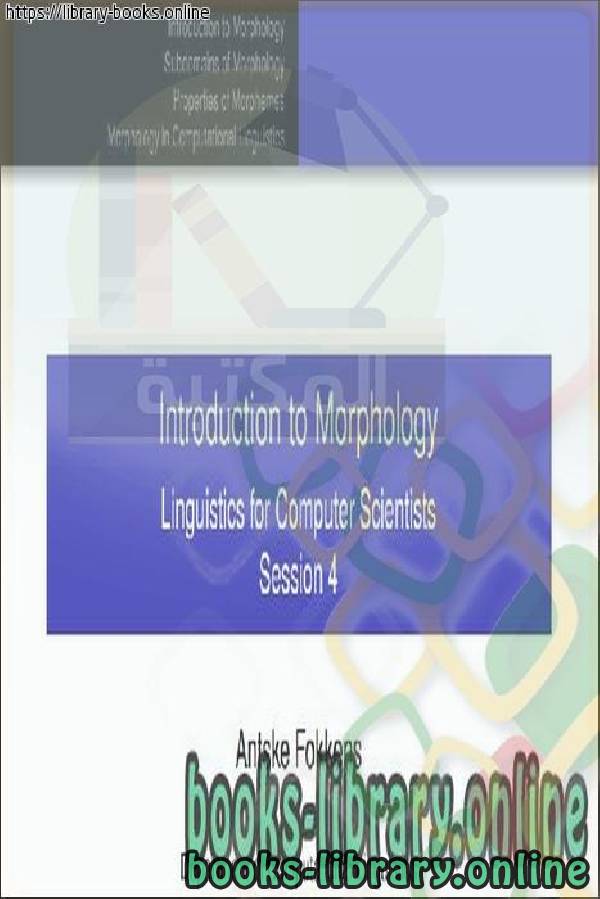
Introduction to Morphology Linguistics for Computer Scientists Session 4 PDF
قراءة و تحميل كتاب Introduction to Morphology Linguistics for Computer Scientists Session 4 PDF مجانا

Understanding Morphology 2nd edition PDF
قراءة و تحميل كتاب Understanding Morphology 2nd edition PDF مجانا
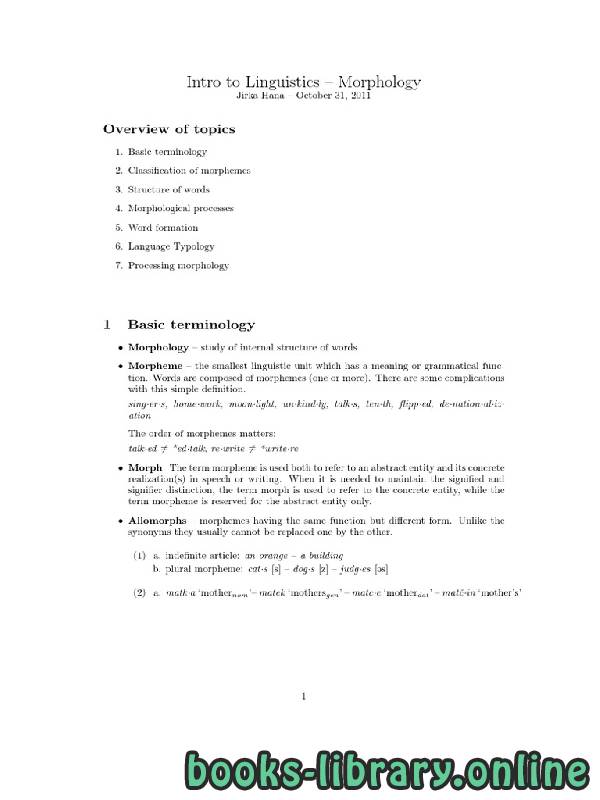
{Intro to Linguistics { Morphology PDF
قراءة و تحميل كتاب {Intro to Linguistics { Morphology PDF مجانا
